The model minority is losing patience
Asian-Americans are the United States’ most successful minority, but they are complaining ever more vigorously about discrimination, especially in academia
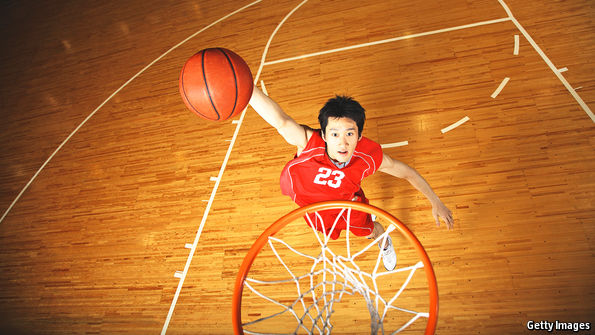
MICHAEL WANG, a young Californian, came second in his class of 1,002 students; his ACT score was 36, the maximum possible; he sang at Barack Obama’s inauguration; he got third place in a national piano contest; he was in the top 150 of a national maths competition; he was in several national debating-competition finals. But when it came to his university application he faced a serious disappointment for the first time in his glittering career. He was rejected by six of the seven Ivy League colleges to which he applied.
“I saw people less qualified than me get better offers,” says Mr Wang. “At first I was just angry. Then I decided to turn that anger to productive use.” He wrote to the universities concerned. “I asked: what more could I have done to get into your college? Was it based on race, or what was it based on?” He got vague responses—or none. So he complained to the Department of Education. Nothing came of it. “The department said they needed a smoking gun.”
In May this year Mr Wang joined a group of 64 Asian-American organisations that made a joint complaint to the Department of Education against Harvard, alleging racial discrimination. That follows a lawsuit filed last year against Harvard and the University of North Carolina by a group of Asian-American students making similar charges. The department rejected the claim in July, but another two complaints have since been filed by Asian-Americans, one against Harvard and one against nine other universities.
On October 3rd 1965 President Lyndon Johnson signed the Immigration and Nationality Act into law, sweeping away a system that favoured white Europeans over other races. One of its main consequences was the beginning of mass immigration to America from Asia. By most indicators, these incomers have done better than any other ethnic minority group. Indeed, they have long been described as the “model minority”: prosperous, well-educated and quiescent. But there are problems, as a result of which they are becoming somewhat less quiescent than they once were.
Before the 1965 act, the experience of Asian-American immigrants had not been entirely happy. The largest mass lynching in American history, in 1871, in which 17 Chinese were murdered; the Chinese Exclusion Act of 1882, which prohibited Chinese immigration; the internment of 120,000 Japanese-Americans in the second world war, when relatively few German- or Italian-Americans were interned: all were symptoms of a racism that was reserved not just for African-Americans.
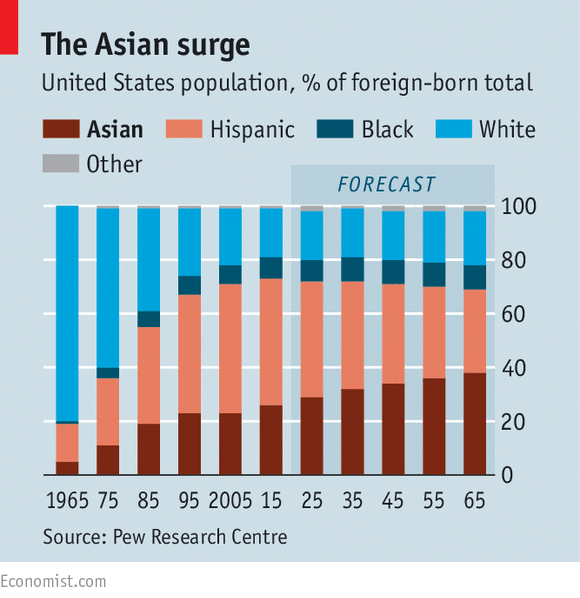
Things changed after the war. The Chinese and Indians were seen as allies, and the internment of Japanese came to be seen as wrong. As the civil-rights campaign changed attitudes to race, the new immigration act enabled people to be admitted on the basis of skills and family relationships. Asia’s large population and fast-developing economies have meant an abundant supply of skilled aspirant Americans. In 2013 the numbers of both Chinese and Indian migrants overtook Mexicans for the first time.
Asia being a big place, Asian-Americans are a various lot, who came at different times, for different reasons and with different levels of education and prosperity. The Japanese mostly arrived before the second world war, the Chinese from the 1980s onwards. The Indians and Chinese are on average well educated and prosperous, whereas the (small numbers of) Cambodians, Laotians and Hmong are struggling. The Japanese—the only Asian group mostly born in America and more likely than not to marry a non-Asian—are closer in attitudes and educational level to the American population as a whole. But on average Asian-Americans are unusually well educated, prosperous, married, satisfied with their lot and willing to believe in the American dream: 69% of Asians, compared with 58% of the general public, think that “most people who want to get ahead can make it if they are willing to work hard.”
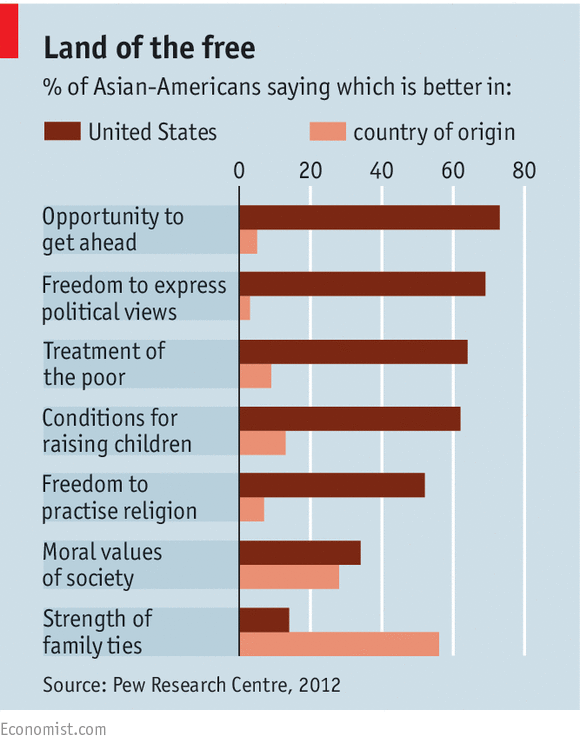
It is their educational outperformance that is most remarkable: 49% of Asian-Americans have a bachelor’s degree, compared with 28% of the general population. Whereas Asian-Americans make up 5.6% of the population of the United States, according to the complaint to the Department of Education they make up more than 30% of the recent American maths and physics Olympiad teams and Presidential Scholars, and 25-30% of National Merit Scholarships. Among those offered admission in 2013 to New York’s most selective public high schools, Stuyvesant High School and Bronx High School of Science, 75% and 60% respectively were Asian. The Asian population of New York City is 13%. Surging immigration is likely to increase the disparity between Asians and other groups, because recent immigrants are even more highly qualified than earlier cohorts: 61% of recent immigrants from Asia have a bachelor’s degree, compared with 30% of recent non-Asian migrants.
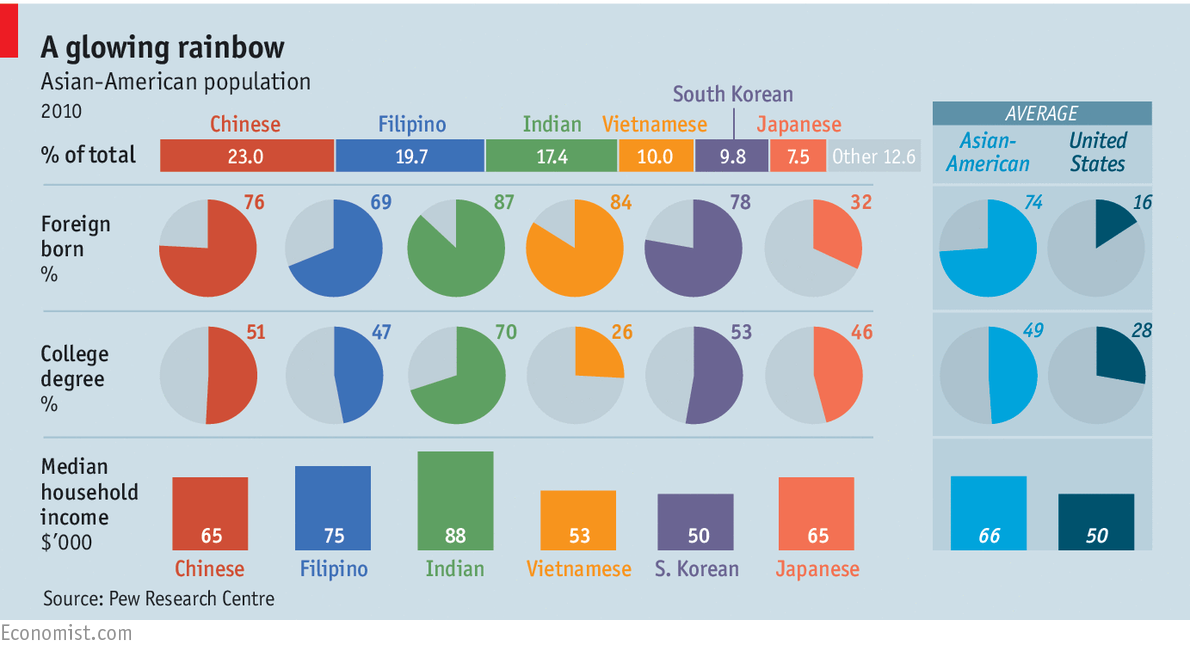
Why do they do so well? Amy Hsin of the City University of New York and Yu Xie of the University of Michigan examined the progress of 6,000 white and Asian children, from toddlers through school, to find an answer. They rejected the idea that Asians were just innately much cleverer than whites: there was an early gap in cognitive abilities, but it declined to insignificance through school. The higher socioeconomic status of Asian parents provided part of the explanation, but only a small part. Their data suggested that Asian outperformance is thanks in large part to hard work. Ms Hsin and Ms Xie’s study showed a sizeable gap in effort between Asian and white children, which grew during their school careers.
When the researchers asked the children about their attitudes to work, two differences emerged between Asian and white children. The Asians were likelier to believe that mathematical ability is learned, not innate; and Asian parents expected more of their children than white ones did. The notion that A- is an “Asian F” is widespread. Another study, by Zurishaddai Garcia of the University of Utah, shows that Asian-American parents are a lot likelier to spend at least 20 minutes a day helping their children with their homework than any other ethnic group.
In “The Asian American Achievement Paradox”, a study based on interviews with young Chinese and Vietnamese in Los Angeles, as well as Mexicans, whites and blacks, Jennifer Lee and Min Zhou argue that it is not just what happens at home that matters. They point to “ethnic capital”—the fact that these groups belong to communities that support education—as part of the explanation.
The Asian-American interviewees recall wearily their parents dangling the PhDs of cousins and neighbours in front of them. Being part of an entrepreneurial society helps. The four-inch-thick Southern California Chinese Yellow Pages, which lists Chinese businesses, offers thousands of listings for Chinese-run SAT prep and tutoring services. Close links to the motherland are also an advantage, to parents at least. Children who rebel may be threatened with being sent to stay with family in China, and they know from relations there that teenagers in America, even Asian ones, get off relatively lightly compared with those in China.
Thanks to such pressures and hard work, many Asian-Americans do end up in top universities—but not as many as their high-school performance would seem to merit. Some Asians allege that the Ivy Leagues have put an implicit limit on the number of Asians they will admit. They point to Asians’ soaring academic achievements and to the work of Thomas Espenshade and Alexandria Walton Radford of Princeton, who looked at the data on admissions and concluded that Asian-Americans need 140 SAT points out of 1,600 more than whites to get a place at a private university, and that blacks need 310 fewer points. Yet in California, where public universities are allowed to use economic but not racial criteria in admissions, 41% of Berkeley’s enrolments in 2014 were Asian-Americans and at the California Institute of Technology 44% were (see chart).
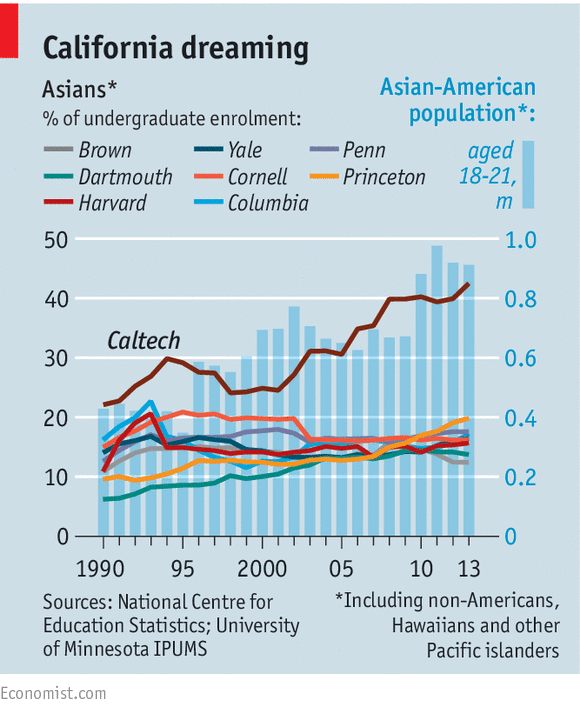
Racial prejudice of the sort that Jews faced may or may not be part of the problem, but affirmative action certainly is. Top universities tend to admit blacks and Hispanics with lower scores because of their history of disadvantage; and once the legacies, the sports stars, the politically well-connected and the rich people likely to donate new buildings (few of whom tend to be Asian) have been allotted their places, the number for people who are just high achievers is limited. Since the Ivies will not stop giving places to the privileged, because their finances depend on the generosity of the rich, the argument homes in on affirmative action.
Several states have banned the use of race as a criterion for admission to their public institutions and there have been several lawsuits against affirmative action. One, brought by Abigail Fisher (who is white) against the University of Texas, has been ricocheting between the Supreme Court and lower courts for seven years; in June the Supreme Court agreed to hear her appeal. In September, 117 Asian-American outfits under the umbrella of the Asian-American Coalition for Education filed a brief to back Ms Fisher. That case’s outcome will bear on the one brought by the group of Asian students against Harvard and the University of North Carolina. Given that several Supreme Court judges, including John Roberts, the chief justice, are unsympathetic to affirmative action, the court seems quite likely to rule against it.
Too successful by half
For the moment the court has taken the view that universities may take race into account, but racial quotas are not on. The Ivies deny running a racial quota. But in its comment on the Asian groups’ complaint, Harvard defends the use of race as a criterion in admission—“a class that is diverse on multiple dimensions, including on race, transforms the educational experience of students from every background and prepares our graduates for an increasingly pluralistic world”—and describes its admissions process as “holistic”, meaning it takes into account considerations wider than mere test scores.
Many Asian parents think this is wrong. They woke up a long time ago to the need to counter the stereotype of the maths-nerd Asian who does nothing but work, and encouraged their children to diversify—into music, debating, charity work, sports, everything that is supposed to increase students’ chances of admission. But many who have excelled in those areas, including Mr Wang and Irene Liu, a student from Massachusetts with a similarly stellar CV, were rejected by the Ivy League. Ms Liu’s mother, Tricia, says, “I feel angry about it. We came for the American dream: you work hard, you do well. This just doesn’t add up.” Irene has accepted a place at a top Canadian university, and is happy about it. Her mother isn’t: “It breaks my heart that she’s going abroad. If she had gone to Harvard, I could have brought her dumplings.”
Mr Wang doubts that Asians, in reaction, are likely to slack off. Asian parenting, he says, “isn’t getting more relaxed. It’s probably getting stricter, because parents realise they’re going to have to work even harder. Standards are rising for everybody, but they’re rising faster for Asians than for everybody else.” As Arnold Jia, a 14-year-old from Short Hills, New Jersey, points out, the problem becomes circular. “To counter affirmative action we have to work harder than everybody else,” he says. “And that reinforces the stereotype.”
But the Asian-American community is unwilling on the whole to oppose affirmative action. It tends to vote Democratic, and many of its members recall the years when they were a despised, not a model, minority. So those who dislike the way the system works tend to argue for it to be adjusted, not abolished; and some say that Asians should actually support it.
It is true that although Asian-Americans do remarkably well at school and university, and have high average incomes, in the workplace they are under-represented in top jobs. A “bamboo ceiling” seems to apply. Asians do well in the lower and middle levels of companies and professions, but are less visible in the upper echelons. Buck Gee, Janet Wong and Denise Peck, Asian-American executives who put together data from Google, Intel, Hewlett Packard, LinkedIn and Yahoo for a report published by Ascend, an Asian-American organisation, found that 27% of professionals, 19% of managers and 14% of executives were Asian-American (see chart).
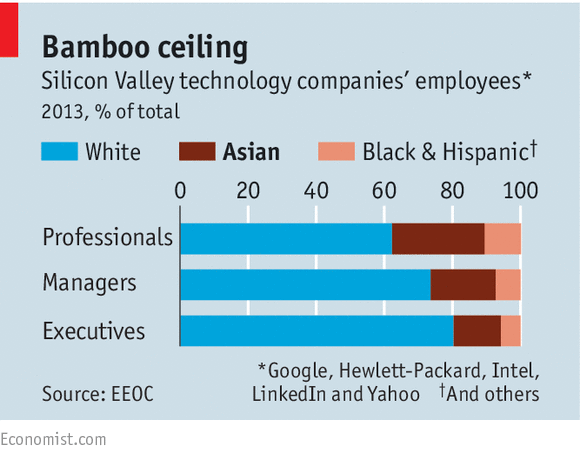
A similar effect is visible in the law. In 2014, whereas 11% of law-firm associates were Asian, 3% of partners were. Recruiters at the top firms typically throw out applications from all but the top universities and scan the remainder for their extracurriculars, says Lauren Rivera of Northwestern University. “They’re particularly interested in sports, such as lacrosse, squash and [rowing] crew. When you look at the demographic base of these sports, Asian-Americans are not heavily represented.”
At the very top of the tree, Asian-Americans are nigh-invisible. According to a study of Fortune 500 CEOs by Richard Zweigenhaft of Guilford College, in 2000 eight were Asian-American, and in 2014 ten were, whereas the women’s tally in the same period rose from four to 24. Academia, similarly, is stuffed with Asian-American professors, but among America’s 3,000 colleges there are fewer than ten Asian-American presidents, says Mr Gee.
High-flying Asian-Americans, like the three authors of the Ascend report, suggest that cultural patterns may contribute to the group’s under-representation at the top. “There’s something in the upbringing that makes Asians shy,” says Mr Gee. “Engineers are nerds, but within that self-selected group of nerds, Asians are even more nerdy.” “We’re brought up to be humble,” says Ms Wong. “My parents didn’t want to rock the boat. It’s about being quiet, not making waves, being part of the team. In corporate life, you have to learn to toot your horn.” “There’s a natural order of human relationships in Confucianism,” says Ms Peck. “You don’t argue, you don’t contradict authority.” Asian-Americans are a large, diverse group exposed to a range of influences, but those who do reflect such patterns may be less likely to bid for leadership, even if they are highly qualified. The comparative prominence of South Asians, who are less likely to be told not to “rock the boat”—for instance, Indra Nooyi at PepsiCo and Ajay Banga at MasterCard—is cited as anecdotal evidence.
Mr Gee, Ms Wong and Ms Peck, who run training courses to help Asians get promoted, recommend that they should network harder. But another study suggests that Asians may find getting mentors particularly tough. Researchers at Wharton Business School, Columbia University and New York University wrote an identical e-mail to 6,500 professors, ostensibly from students wanting to meet the academic. White men got notably more responses than other groups; Asian-Americans of both sexes got fewer. Since the Ivies produce a disproportionate number of CEOs, Congressmen and judges, the apparent bias against Asian-Americans at leading universities may also keep Asians out of leadership spots. “The ladder is being pulled away from our feet,” says Tricia Liu. “If we can’t go to the Ivy League universities, how can we get the positions in Wall Street, or Congress, or the Supreme Court?”
As Jerome Karabel’s study of Jews and the Ivy League (“The Chosen: The Hidden History of Admission and Exclusion at Harvard, Yale and Princeton”) shows, it was only when Jews had gained political power that the Ivies stopped discriminating against them. And Asian-Americans are under-represented in politics as well as in business. Only 2.4% of the 113th Congress were Asian-Americans; by one count, fewer than 2% of state legislators are.
Where is Senator Kim?
South Asians, though less numerous than East Asians, are more visible. Nikki Haley, governor of South Carolina, and Bobby Jindal, governor of Louisiana, both Indian-Americans, are the only Asian-American governors in the lower 48 (David Ige, a Japanese-American, is governor of Hawaii). The contrasting political traditions of India and China may also be a factor. “We come from the largest democracy in the world,” says Sayu Bhojwani, who runs the New American Leaders project, which helps train immigrants to flourish in politics. “We’re prepared for it in the way that East Asians are not.”
In China, by contrast, “We went through the cultural revolution,” says Chunyan Li, a former employee of the Chinese finance ministry, now a professor of accountancy at Pace University in New York. “There’s a lack of trust in politics.”
Perceptions that Asian-Americans are being treated unfairly, especially in the workplace, may push more of them into politics. Andrew Hahn, a Korean-American partner in Duane Morris, a law firm, says, “I used to be a Twinkie, or maybe a banana—yellow outside, white inside—but once I hit the legal profession, I became a radical.”
College admissions—and the lawsuit against Harvard—may provide a spark to fire Asian-Americans into becoming more assertively political. Many in California were infuriated last year by a bill to rescind the state’s ban on using race in university admissions promoted by a Hispanic state senator. A Change.org petition and 36 organisations, 26 of them Asian-American, opposed the bill, and it was dropped. “There’s a growing community angst,” says Mr Hahn of the belief among Asian-Americans that they are being discriminated against. “What’s next? Law school admissions? Employment?” He organises political fund-raisers, and says that the coffers have opened. “Hedge-fund money, private equity, lawyers. They’re giving huge sums …It took the Jews half a century to get where they are,” he adds. “I hope it doesn’t take us that long.”
From the print edition: Briefing
Source: The model minority is losing patience | The Economist